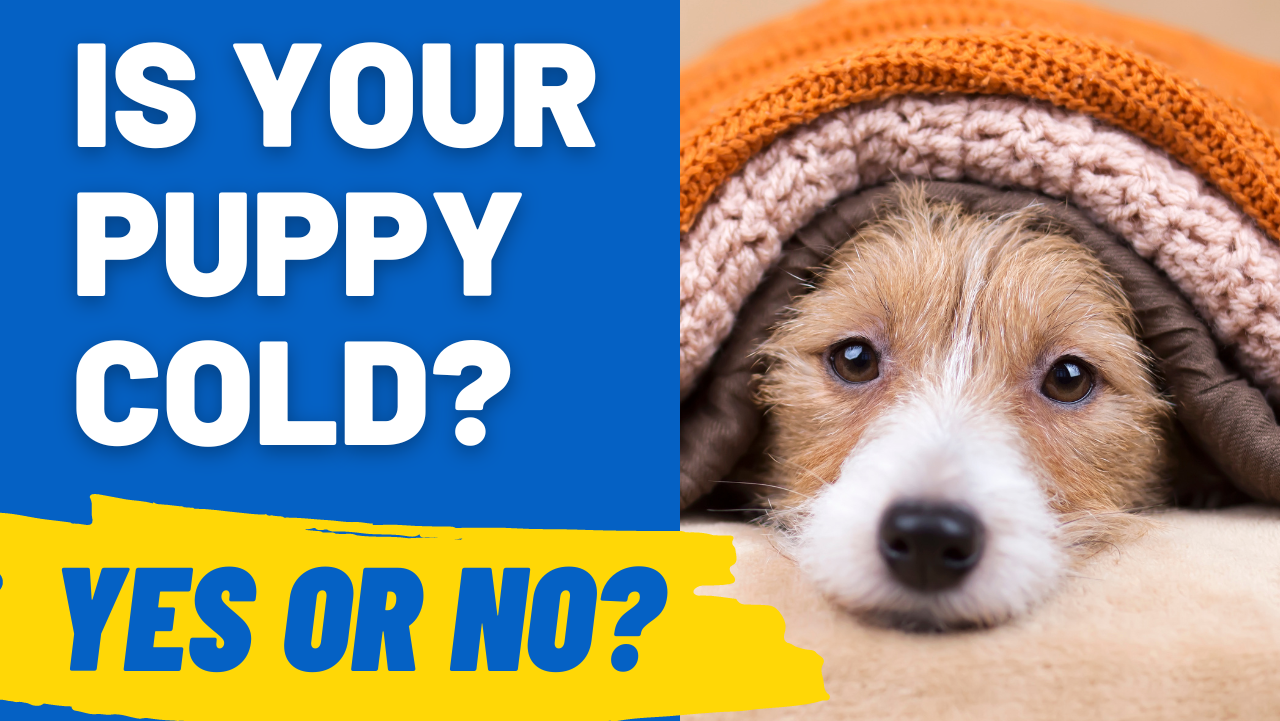Given the differing climates we each live in, as well as the different types and lengths of fur that each puppy may have, there’s no one-size-fits-all when it comes to temperature. Instead, it’s important that you recognize the signs that your individual puppy is too cold, so you can adjust their environment accordingly.
Signs Your Puppy is Cold
If your puppy is cold, you may notice some of the following signs:
- Shivering or shaking
- Curling up into a tight ball to sleep
- Tucking their nose under their tail
- Burying under a blanket
- Anxious behavior, such as being restless or whining
- Lifting their paws off of the ground
Of course, these signs may also occur in other situations, such as when your puppy is scared, sick, or just trying to be comfortable and cozy.
So, if you notice any of the above signs and are worried your puppy may be cold, it’s important to investigate the situation further to confirm…
How Cold is Too Cold for a Puppy?
In most cases, puppies can be comfortable at temperatures 45°F (7°C) or warmer. However, dogs that are either very young, smaller in size, or have shorter fur, will usually get cold faster.
So, while you can often assume 45°F is warm enough for most dogs, you should still keep an extra close eye on dogs that may be more susceptible to the cold. Shorthaired breeds fall into this category, such as a young French Bulldog or Italian Greyhound.
If temperatures reach 32°F (0°C) or lower, dogs that are very young, or are sick, or have a short/thin coat of fur, can become cold very quickly.
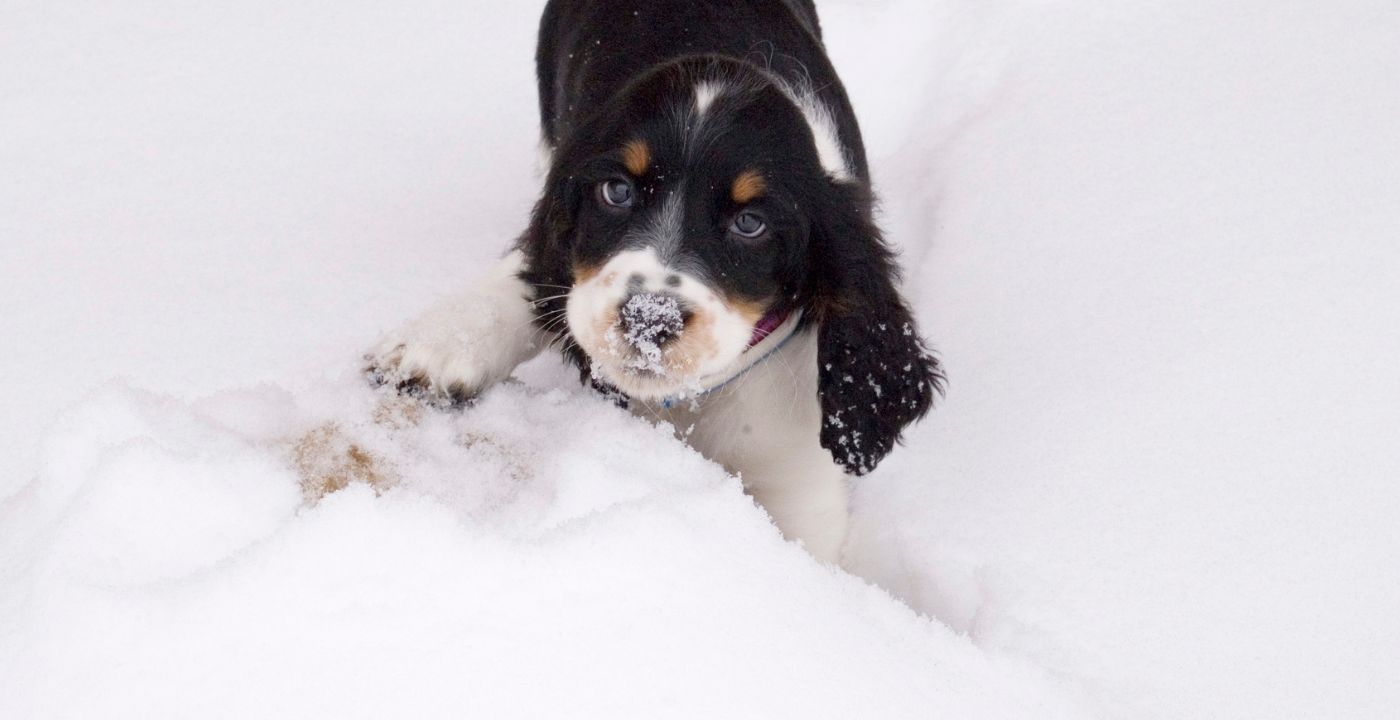
Owners of puppies fitting these characteristics should pay special attention when temperatures are at or below freezing. If you have a young puppy with a short coat, avoid spending long periods of time in low temperatures.
Even the most fluffy, large-breed dog may still be susceptible to the cold, though. Whenever the temperature is 20°F (-6°C) or colder, any dog may develop frostbite or hypothermia if the conditions are poor.
Some dogs may love spending time outside in these cooler temps because they are built for cold climates, but they still need to be monitored to ensure they don’t become too cold.
New puppies often shake due to a variety of reasons, including being too cold, being scared, being hungry, or they may even have Shaking Puppy Syndrome.
How Do You Know if a Puppy is Warm Enough?
When your puppy is warm enough, they should be happy, playful, and bouncy, rather than stiff and still and tucked in on themselves to conserve warmth. They may still choose to curl up to sleep, or even to sleep under a blanket, but they shouldn’t be shivering.
You can also feel your puppy’s body, especially their ears and feet, to ensure they are not cold to the touch. If you do this, it’s important to feel under their fur where it’s close to their skin, for an accurate feeling of their body temperature.
A dog’s coat may be colder or warmer than the dog’s actual temperature. This is especially true if they have recently been out in the cold, sitting in the sun, or if their coat is thick and further from their skin.
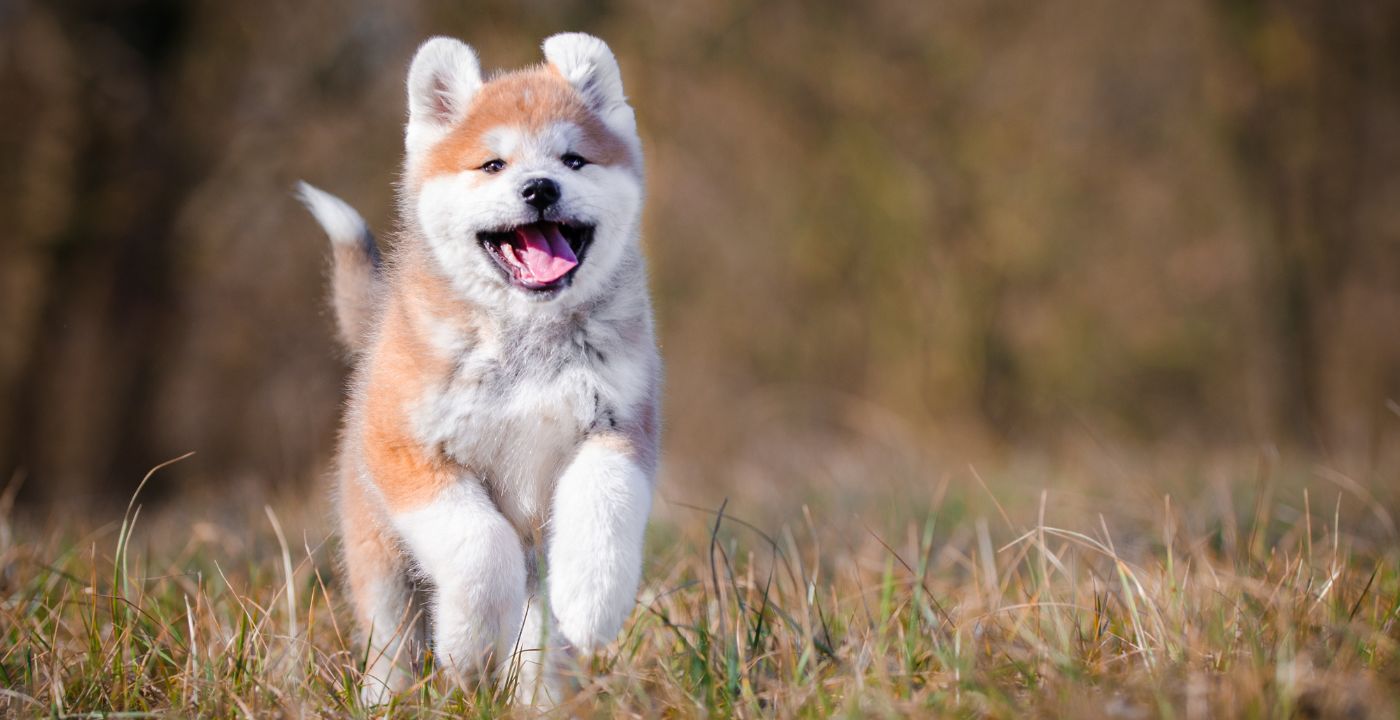
Puppies may sometimes have ears or feet that feel cold even when their core body temperature isn’t cold, especially if they have recently been in cold or damp weather.
In addition, cold ears and feet may sometimes indicate a health condition. Thus, you should consider the temperature of a puppy’s ears and toes as just one piece of the puzzle and not a universal indication of body temperature.
Do Puppies Get Cold Easily?
Because of their young age and smaller body size, puppies will get cold more easily than adult dogs. With age, they will be able to control their body temperature more reliably, and they will also develop an adult coat of fur that may better protect them from the cold.
Dogs that are fluffy, like a fluffy corgi, and have thick, plush coats as adults, are born with a short coat that grows as the puppy ages.
While puppies of double-coated breeds may have developed a more fluffy coat by the time you bring them home, this coat is often called a “puppy coat”. This puppy coat will eventually be replaced by a coat that has a more distinct undercoat (to keep them warm) and an outer coat (to protect them from the environment).
My dogs are Nova Scotia Duck Tolling Retrievers, and are generally quite fluffy and can handle the cold weather. When I brought Windi home at 10 weeks of age, he had an adorable, soft, and puffy coat.
Within a few months, most of this “puppy coat” was gone, and he looked quite naked in comparison! He now has a thick and fluffy coat as an adult and loves to spend time outside in cold weather and snow.
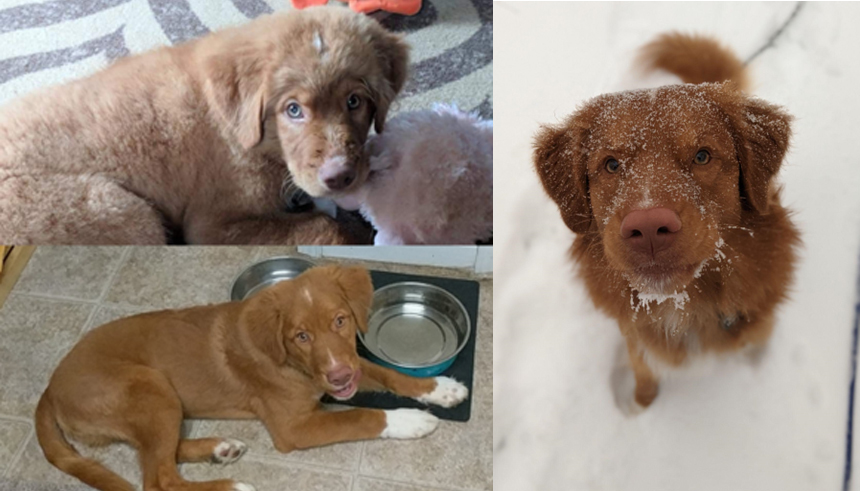
How Do You Know If Your Dog is Cold in the House?
Even if your puppy is inside your home, rather than outside in the cold weather, some dogs may still become cold.
Again, this is most often the case for dogs that are small, very young or seniors, sick, or have short fur. While they aren’t likely to suffer frostbite or hypothermia within your home, they may still seek extra warmth.
If your puppy tends to seek out blankets, snuggles with another pet or person, or a vent with warm air, it’s possible that they become cold more easily.
It’s also possible that they just enjoy the company of whoever they are snuggling with, or that they love the comfort of the blankets!
You likely don’t need to do anything differently if your dog is seeking out extra warmth in your home, as long as they have options, such as blankets or a heater to sit beside.
My dogs have longer coats to keep them warm, so they aren’t cold very often. Instead, they tend to become too warm and seek places to sleep to cool them off.
In the summer I often find them napping on the tile in the bathroom or the cement floor of the unfinished half of the basement. Once I even saw Hobbes pull a dog bed out of a crate so he could sleep on the plastic bottom instead.
Similar situations, but in reverse, will occur when dogs are too cold. This is just a normal part of the fluctuations in body temperature an individual feels throughout the day. You can help your dog feel more comfortable by providing them with blankets, beds, or even clothing that can help keep them warm.
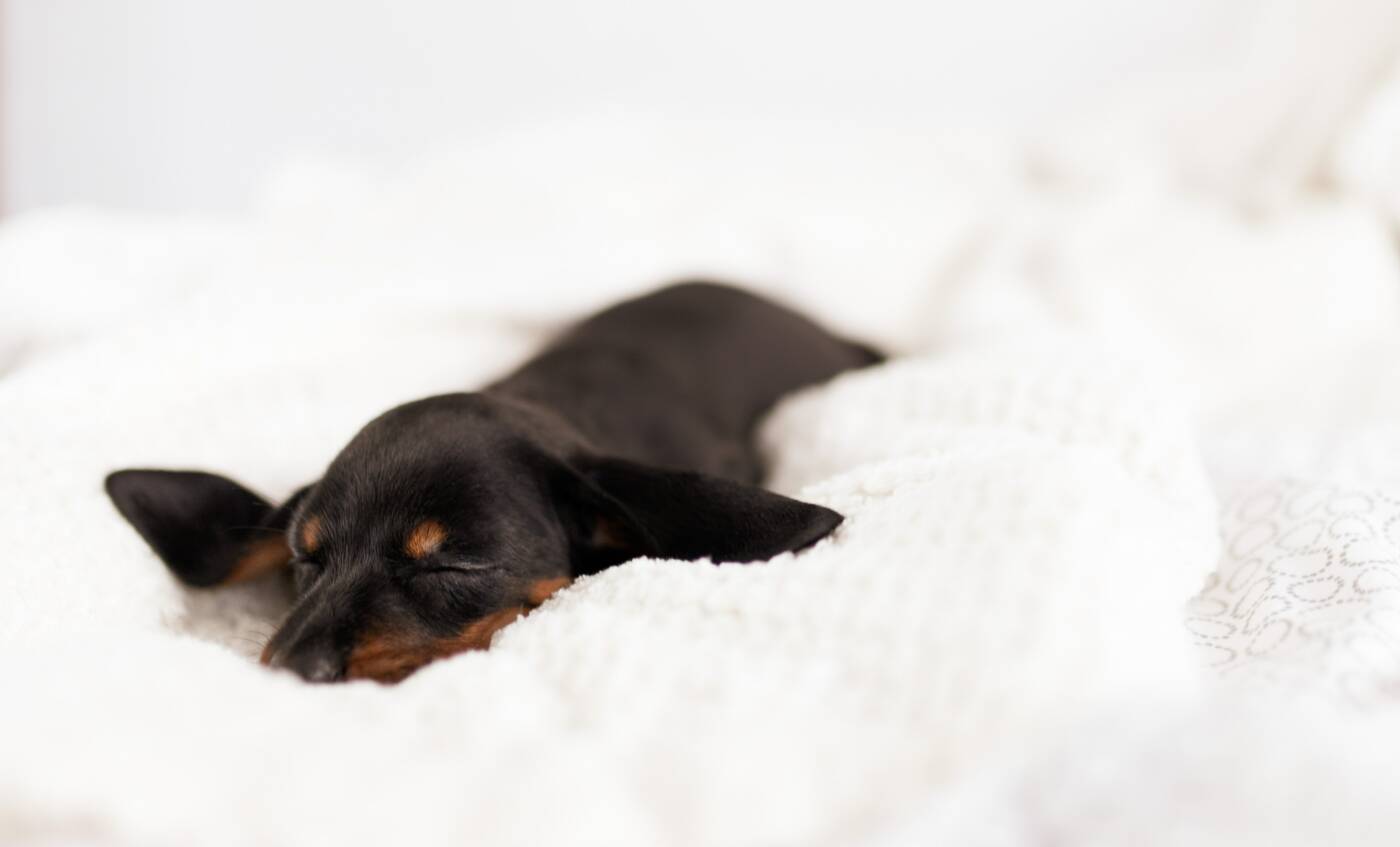
Is My Puppy Too Cold at Night?
If your puppy is sleeping in your home, and your home is at a comfortable temperature for you to sleep, your puppy should not be so cold they are at risk of hypothermia. However, that doesn’t mean they are completely comfortable with the temperature in your home.
Puppies may benefit from a blanket or bed to sleep on to provide some extra warmth if you notice they are curled up tightly or shivering and seem to be cold.
We love the blankets you can get from Paw, just because they’re super fluffy and warm!
Some puppies also enjoy sleeping with a warm water bottle or a toy designed to mimic their littermates, both in warmth and with a fake heartbeat:

However, just because a puppy may be sleeping alone at night does not mean they will be too cold. My dogs have always experienced the opposite – in their kennel, with blankets, they are usually too hot! Instead, they prefer to sleep on a thinner cushion, or just the plastic bottom.
Your puppy should not need you to turn on your heating at night, or to take other special measures besides ensuring they have a blanket or other way to be warm if they seem to prefer it (and can be trusted not to ingest it).
Does My Dog Need a Blanket at Night?
Puppies that are often cold may enjoy sleeping with a blanket at night, but blankets are not a requirement. In fact, for puppies that may chew on the fabric and ingest pieces of it, blankets can pose a risk.
Whether you should give your dog a blanket at night or not depends on your individual dog, both on their preferences for blankets and their tendencies to chew and eat the blankets (or not).
My dogs enjoy blankets or a pillow just for comfort, but they often get too hot if they are crated with a blanket, unless they have room to move the blanket out of their way.
I also did not usually give them a blanket in their kennel when they were young puppies, both because of their tendency to chew as well as the fact that they were less likely to have an accident if the blanket wasn’t there to soak up any urine.
What Temperature Do Dogs Like to Sleep In?
A dog’s coat, age, size, and even tolerances they have built from living in a certain climate will all play a role in your dog’s ideal temperature for sleeping.
Dogs with short or thin coats, such as a Greyhound or Boxer, will usually prefer warmer temperatures than a dog with a double coat, such as a Bernese Mountain Dog or German Shepherd.
Very young puppies and senior dogs will also prefer the warmth, as well as dogs that are sick or have certain health conditions. Dogs in these categories may not be able to regulate their body temperature as easily as the average healthy adult dog.
Most dogs will be able to sleep happily in homes kept at temperatures that are comfortable for us as people – and most people keep their homes at temperatures somewhere between 68°F (20°C) and 76°F (24°C).
Can You Tell Your Dog is Cold From Their Ears?
Feeling your dog’s ears can sometimes indicate if they are too cold, but they may also have cold ears for other reasons. When your dog’s ears are cold, it indicates there is reduced blood flow to their ears, and the cold isn’t the only reason this can occur.
Medical reasons for your dog’s ears to feel cold include hypothyroidism, anemia, dehydration, congestive heart failure, or ear margin necrosis. All of these illnesses will also have other symptoms, though, so don’t worry if your puppy’s only symptom is cold ears!
Ears may also be cold from the colder temperature of the environment, especially if your dog has been outside in the wind, snow, or rain. I’ve also noticed a dog’s ears being cooler to the touch when they are sleeping in front of the fan.
So, while cold ears may be a sign your dog is cold, you need to look at the entire situation and consider cold ears as just one piece of the puzzle.
If your dog’s ears are hot, on the other hand, we have this post for you, Dog’s Ears Are Hot: Why and What to do.
Is My Puppy Cold or Scared?
Shivering, shaking, curling into a small ball, whining, pacing, and more – all of these signs that your puppy is cold may also be signs that your puppy is scared. Rather than only considering one sign, you’ll always need to consider your puppy’s overall behavior and the entire situation to decide if they are cold or scared.
If they are cold, they may be seeking warmth, and access to warmth should also reduce the shivering, shaking, or other behaviors you are seeing.
Puppies that are scared will likely be trying to move away from a scary thing, rather than towards something warm, and whether they are warmer or not will not affect their shaking.
What to Do if Your Puppy is Cold
If your puppy is cold, you should ensure they have a way to warm themselves up. This may mean providing them with a blanket, a sweater, or a cozy space. It also means that if you are outside in the cold, you should move indoors or find another way to warm up your puppy.
Puppies that are too cold for too long, at temperatures below freezing (32°F/0°C), can suffer from hypothermia or frostbite. It’s important to monitor puppies closely at these low temps to avoid medical problems from arising.
If temperatures are above freezing, your puppy isn’t likely to suffer ill effects other than discomfort. If it’s a regular experience, though, I’m sure your puppy would still definitely appreciate any efforts to keep themselves warmer and more comfortable.

